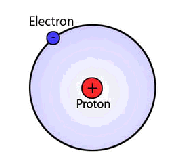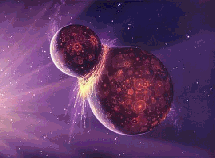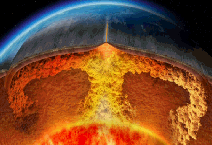In the New Testament, John in Chapter 3 states, 'Truly, I say unto you, unless one
is born again he cannot enter the kingdom of Heaven.' What does it mean to be
'born again,' or to come back to life?
The word Easter is derived from Eostre, an ancient Anglo-Saxon goddess. She
symbolized the rebirth of the day at dawn and the rebirth of life in the spring. The
theme of rebirth is integral to the natural world. Life does in fact reinvent itself
every spring, and the arrival of spring was celebrated by people all over the world
long before the Christian religious meaning became associated with Easter.

Avalanche lilies die above ground in summer, only to reappear & bloom through the melting snow the next spring.
|
Albert Einstein hinted at the possible meaning of being born again, into a deeper
reality. He observed, when thinking about the larger world beyond individual
consciousness, 'The human mind is not capable of grasping the universe. We are
like a little child entering a huge library. The walls are covered to the ceilings with
books in many different tongues. The child knows that someone must have written
these books. It does not know who or how. It does not understand the languages in
which they are written. But the child notes a definite plan in the arrangement of
the books, a mysterious order which it does not comprehend, but only dimly
suspects.' Einstein is referring to the overall universe, which in many ways is intricately ordered.
Science seeks to understand the world, but as Einstein noted, much of what science uncovers is beyond what we
call rational understanding. Let's start with the Big Bang. As one cosmologist put it, 'First there was nothing, and
then it exploded.' Everything appeared from nothing. It sounds improbable.
We have an immediate problem right at the beginning of the story, with everything appearing from nothing. The
biologist Terrance McKenna offered this perspective: 'The idea of the Big Bang is hard to swallow. This is the
notion that the universe, for no reason, sprang from nothing in a single instant. Notice that this is the limit test for
credulity. Whether you believe this or not, notice that it is not possible to conceive of something more unlikely or
less likely to be believed! It’s just the limit case for unlikelihood, that the universe would spring from nothing in a
single instant, for no reason?! What science is saying is, just give us one free miracle and we'll take it from there.
Well, I say then, if science gets one free miracle, then everybody gets one free miracle.'
There is scientific evidence that the universe is expanding outward in all directions from a single point, and that in
the very early universe the only elements that existed were hydrogen and helium.

Hydrogen has one proton in the nucleus and one electron in the electron shell. But, that shell holds two electrons. The rest, as they say, is history.
|
As you more or less know, the electrons in the various elements fly around in
'orbitals' or 'shells' outside the nucleus. As fate would have it, the first shell holds
only two electrons. Helium has two electrons, so it's shell is full, and it is inert, it
does not react with other elements. But hydrogen only has one electron; and here's
the strange thing. Any element that does not have its outer electron shell full wants to
find a way to fill it (in the sense of having a magnetic electrical charge), by sharing one or
more electrons with another element. This electrical proclivity to partner to fill
electron shells is the first step on the road to the evolution of increasing complexity.
Oxygen has 8 protons and 8 electrons, so the first two electrons go in the first shell
and fill it, the remaining 6 go in the second shell, but that one holds 8 (by law), so
oxygen 'wants' two more electrons. If it shared one each with two hydrogen atoms
then both the hydrogen and oxygen atoms would have full shells-and water, H2O, would be the result. Most of the
elements want to combine with other elements to fill their outer shell. Thus evolution was inevitable from the
moment of 'creation,' due to the electrical proclivities of individual atoms. It is also notable that the process is
'emergent'; new phenomena appear from old. In the case of hydrogen and oxygen, two gases combine to make a
liquid (or a solid or a gas, depending on temperature).
About 5 million million (5 trillion) hydrogen atoms would fit on the head of a pin, so we talking about something
on a near-miraculous scale here. First we had a universe appear out of nothing, and now we find its unimaginably
minute constituent parts have a profound order built into their structure. It's possible that the structure of the
universe may be beyond our capacity to understand. It's also possible in our emergent universe that we may be
'born again' into a new, deeper perception of our world.
Ilya Prigogine, a recipient of the Nobel Prize for chemistry, noted that, 'The statistical probability that organic
structures and the most precisely harmonized reactions that typify living organisms would be generated by
accident, is zero.'

Like much of the universe, snowflakes are very orderly, even while each one is unique.
|
'There is no shortage of ordered self-assembly in the universe, from snowflakes
to the rings of Saturn,' notes Belgian biochemist and Nobel laureate Christian de
Bude. 'So powerful is this natural impulse to assemble that many scientists now
believe that life may be more inevitable than we think. Life may be an
obligatory manifestation of matter, bound to arise wherever conditions are
appropriate.'
The early universe contained only hydrogen (one proton in the nucleus) and
helium (two protons), so all of the other 92 naturally occurring elements that
exist today (like carbon, oxygen, nitrogen, etc) somehow 'emerged' as the
universe evolved. This phenomenon of emergence is very powerful, and if you
are looking for hope for the future, there it is. The available evidence indicates
that the larger elements were fused from smaller elements in the extreme heat
and pressure at the center of stars, and in super novae explosions. Thus your body, which is 65% oxygen and 18%
carbon, is made of elements that were fused in stars and super novae explosions. That is an auspicious beginning of your life story.
Our sun is 93 million miles away, and yet it manages to heat the earth even at such a distance. What is it burning? I
like to ask children: Is the sun burning firewood or coal? In fact the sun is fusing hydrogen into helium, a one
proton nucleus into a two proton nucleus. There is slight loss of mass in the helium product; the missing mass is
transformed into energy according to this formula mysteriously deduced by Einstein: E=MC2. That is, energy (E,
the energy in mass) equals the mass of an object multiplied by the speed of light squared (the speed of light is
186,000 miles per second; and as one physicist's tee-shirt notes, the speed of light is not just a good idea, it's the
law).
The sun is 'burning' (fusing) 600 million tons of hydrogen per second. It is not alone in this work; there are
estimated to be 2 trillion galaxies in the universe, each with 100 to 200 billion stars.
For better and for worse, the universe is expanding outward. The expansion rate of the universe determines what
kinds of stars, if any, will form, because it is the countering force of gravity that causes hydrogen clouds to contract
into stars. If the universe were expanding slightly more rapidly, it would overcome the force of gravity and no stars
would condense from the random clouds of hydrogen. If the rate of expansion were slightly less, the whole
universe would have recollapsed before any stars could have settled into a stable hydrogen-fusing phase. How
critical is this expansion rate? According to MIT physicist Alan Guth, it must be tuned to an accuracy of one part in
1055 (54 zeros is a septendecillion).

The earth’s moon formed when a planetessimal collided with the planet, remelting the earth and blowing crustal material into earth orbit.
|
Our current best evidence is that our moon was formed when a smaller planet smashed into earth early in our
planet's history. This sent a portion of the crust into an orbit around the earth that later accreted into the moon. The
collision was powerful enough to re-melt most of the earth's minerals, allowing the bulk of heavy elements (mostly
iron) to sink to the earth's core. If this collision had not occurred: 1) The Earth's magnetic field, which is generated
by our iron core, would be absent or much weaker, which would allow far more high-energy cosmic radiation to
reach the earth than does with this shield, making life on land almost
impossible. 2) The collision knocked the earth's orbital axis relative to the
sun off from 0° to about 23.5°. Without this tilt there would be no seasons,
and vastly less biological diversity on the planet. 3) Without the moon there
would be almost no tides, reducing the dynamic interaction of land and
water and the resulting diversity of habitats and lifeforms. 4) The collision
of the small planet with the earth resulted in the ejection of the majority of
the earth's primordial atmosphere, which was mostly carbon dioxide, into
space. If this collision had not occurred, we would have had an atmosphere
similar to that of Venus, which is 80 times denser that of the earth
(equivalent to being one mile beneath the ocean). 5) The collision thinned
the earth's crust; without the impact plate tectonics might not ever have been
initiated.
Earth's orbit is just the right distance from the sun for water to exist in three states; liquid, solid and gaseous. If the
earth didn't spin it would freeze on one side and bake on the other. The earth is just the right size; if it were smaller,
lighter elements and gases (H, He, N2, O2, CO2, H2O)
would not be held by the earth's gravity and would fly off
into space. If it were larger, the heat at the core would not create convective currents that drive plate tectonics.
Somehow the earth itself manages to maintain a condition of relative stasis in spite of constant changes on its
surface. For example, salt runs to the sea at a rate fast enough to raise the salinity of the ocean to the deadly 5% salt
level within 800 million years, but this has apparently never occurred. Rain falls at a rate fast enough to fill the
oceans in 60,000 years, yet they never overflow. The rate of erosion is so rapid that sufficient solid material to fill
the ocean basins would be brought down in 17 million years, yet they are never full. Carbon dioxide constantly
leaks into the atmosphere, but it composes only a tiny portion of the air mixture. Oxygen is constantly pumped into
the atmosphere but never exceeds 21%. Nitrogen is constantly removed from the atmosphere by lightening yet
composes nearly 80% of the atmosphere. The earth would appear to be self-regulating.

Plumes of 5000°F magma rising from the lower mantle drives plate tectonics.
|
All of the nutrients that make life possible on land have been running to the
sea for 4 billion years, and yet they are still abundant on land. How is this
possible? Although the earth is 4.5 billion years old, there is no ocean crust
older than 200 million years old. Through the process of plate tectonics,
ocean crust is constantly subducting under continental crust, and then
reappearing as uplifted mountains and exploding volcanoes—bringing the
nutrients necessary for life back to land.
Molecular biology has shown that even the simplest of all living systems on
the earth today, bacterial cells, are exceedingly complex objects. Although
the tiniest bacterial cells are incredibly small, each is in effect a veritable
micro-miniaturized factory, containing thousands of exquisitely designed pieces of intricate molecular machinery,
made up altogether of one hundred thousand million atoms, far more complicated than any machine built by
humans.
The human body is made up of 50 trillion tiny human cells, all working together, all evolved from a single cell, the
fertilized egg. How did the egg know how to build the vast complexities of the body? A blue whale, the largest
animal ever to live on the Earth, has about 100 quadrillion cells, 2000 times more than the human body. Somehow
all of these cells work together to make a highly functional whale.
The human body is also host to a estimated 80 trillion bacterial cells. The average diameter of spherical bacteria is
0.5-2.0 µm (micometers, 1 millionth of a meter, one thousandth of a millimeter). In addition, the approximate
number of virus particles in the human body at any given moment is roughly 380 trillion. These average about
100 nanometers in diameter; a nanometer is a millionth of a millimeter in diameter.
Why do we breath? To obtain oxygen. What does the oxygen do?

To have a happy life, don’t take photosynthesis for granted.
|
During the process of photosynthesis, using the energy arriving from the sun,
plants break water apart, taking the hydrogen from water and attaching it to
carbon dioxide acquired from the atmosphere, while the oxygen from the
water is released to the atmosphere. The carbon dioxide + hydrogen are
transformed into sugar, C6H12O6.
Sugar has energy in it, as we know, which is
in fact the energy of sun, captured in the positioning of electrons in the
chemical compound. When oxygen, which is one of the most electronegative
of all the 92 elements (which means it attracts electrons), encounters the
sugar molecule it pulls it apart, pulling electrons from the sugar close to it's
own nucleus, which releases some of the solar energy captured in those
electrons. The result, after breaking apart the sugar molecule, is carbon
dioxide, water, and the release of this energy of the sun, which had been
stored in the hydrocarbon bonds of the sugar.
So, why do we breathe? To acquire oxygen, which will then metabolize the hydrogen bonds in the food we eat, and
release the energy, which came from the sun and was originally captured by plants, that makes our lives possible.
The biochemical evidence is that life arose only one time on the earth, and from that one-time apparition life
diverged into the estimated 10 to 20 million species on the planet today. The fact that life appeared only once on the
planet means we have a lot of relatives. As Unitarian minister Marlin Lavanhar observed, 'We have all heard some
fundamentalist-minded person say something like, 'Don't tell me I'm related to monkeys.' The fact of the matter is
that now that we have discovered DNA and its code, we know that we are not only related to monkeys, we are
related to zucchini. So let's get over it.'
There is another dimension to life besides the emergence and diversification of life, and that is the fact of periodic
violence, for example when an asteroid hit the Earth 65 million years ago and drove the dinosaurs to extinction.
That particular extinction event is one of five very large die-offs that we know of through the Earth's history, along
with many smaller ones. The largest was the Permian extinction 250 million years ago that wiped out about 85% of
all species on Earth, thought to have been caused by a huge outpouring of molten magma and carbon dioxide in
Siberia. The lava from that outpouring covered three million square miles, about the size of the United States minus
Alaska.
Furthermore, while plants create their own food though photosynthesis, most animals have to kill and eat something
every day to survive. Certainly if the entity being killed is an animal it is never a willing meal and there is violence
involved in dispatching it. 'Life consuming life-that is the essence of its being, which is forever a becoming,' says
Joseph Campbell in his book Myths to Live By. 'The world,' said the Buddha, 'is an ever-burning fire.' ‘And so it is.
And that is what one has to affirm, with a Yes! A dance! A knowing, solemn, stately dance of the mystic bliss
beyond pain that is at the heart of every mythic rite.'
It should be noted that, while diversity, especially within our own species, is always challenging for humans, it is
one of the dominant themes on our planet; the diversification of life. Without the explosive creation of the moon,
the movement of continents and the subduction and cycling of ocean plates, and without the many extinction events
that have occurred and a constantly changing climate, life on earth would not be anywhere near as diverse as it is
today.
In summary, there is more to life (and death) than meets the eye. When I was 18 I worked on a Mennonite farm for
the summer, and I ran across this short statement in a book titled Protestant Mystics of the experience an older
woman had while sitting on her porch, when suddenly her percepion of the world shifted dramatically. I had a
personal experience near that time in my life which confirmed this woman's observations. She wrote,
'Once out of all the gray days of my life I have looked into the heart of reality, I have witnessed the truth, I have
seen life as it really is, ravishingly, ecstatically beautiful, and filled to overflowing with a wild joy and a value
unspeakable. For those glorified moments I was in love with every living thing before me; there was nothing alive
that was not a miracle; just to be alive was in itself a miracle. My very soul flowed out of me in a great joy.'
|
ABOUT THE AUTHOR
Dana Visalli is a professional botanist and organic farmer living in Washington State, USA. He has a bachelor's degree in Biology from the University of New Mexico, and a master's degree in Environmental Studies from Norwich University. He has lived off-grid for the past 20 years, has traveled to Afghanistan and Iraq as a pro-sanity activist, and finds using his composting toilet to be a ‘deep ecology’ moment. His web page is The Methow Naturalist.
|